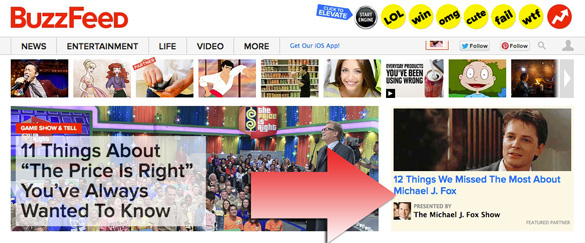Lesson Outline
One of the key News Literacy concepts is knowing which “News Neighborhood” you are in. But discerning the difference between news and other forms of information – such as advertising – is becoming harder and harder in the Digital Age. Welcome to the brave new media world of “native advertising” and “sponsored content,” and the increasingly blurry line of where “editorial” content ends and advertising begins.
Here's one recent example.
The Newest in Native: Editorial Reviews Reborn as Ads
CNET, a CBS-owned website that publishes reviews and news on technology and consumer electronics, sold the right to promote one of its editorial reviews to smartphone manufacturer Samsung. Under the headline “The everything phone for (almost) everyone,” the review by a veteran CNET journalist gave the device 4.5/5 stars. “For an advertiser like Samsung,” as the report notes, the “positive CNET review is probably worth more than a display ad bought on the site.”
But CNET executives were so concerned that the editorial-turned-ad might harm the credibility of the publication that they commissioned a study, which showed that the practice did not “significantly affect” readers’ perceptions. “We are nothing if we don’t have editorial integrity,” said CNET's head of global ad sales.
But what’s the big deal? After all, “pretty much everyone” is doing native advertising now,
 Pretty Much Everyone is Doing Native Ads Now
Pretty Much Everyone is Doing Native Ads Now
and like it or not, the trend isn’t going away. For many publishers, such as the industry upstart Buzzfeed, licensing journalistic content to brands for their own use is a huge moneymaker.
Buzzfeed's Jonah Peretti Says the Site is Profitable, with 85M uniques and 300+ employees
Even the New Yorker and other prestigious legacy brands are getting into the act.
Although native advertising is attractive to publishers, it also presents the potential of confusion, controversy, and conflicts. How is the news different from ads – and how hard is it to tell the difference? How reliable is journalism when it is unclear where it ends and advertising begins? Do ads that look like editorial make publications less independent? How difficult is it for consumers to know what “news neighborhood” they are in? And perhaps most important: What could come next?
What if, for example, a brand commissioned an editorial review, instead of buying rights to it after the fact? CNET for one says it will not permit the practice -- but its easy to imagine the many possibilities --- publishers could promote glowing book reviews, restaurants could pay to highlight positive dining columns, etc. Another possibility is to permit “conquesting,” which allows a company to promote a negative editorial review of a rival’s product. CNET said there are no plans for that... right now. But if they allowed conquesting --- would it matter? Why?
Supplemental Media and Content:
For a closer look at Native Advertising, check out the links below for more info and media that you can use in this lesson:
This infographic from the Solve Media Blog is targeted to advertisers to tell them why they should utilize Native Advertising.
http://news.solvemedia.com/post/37787487410/native-advertising-in-context-infographic
This article explains some of the iterations of Native Ads online.
http://paidcontent.org/2013/09/22/native-advertising-101-understanding-the-native-continuum/
The site BuzzFeed has become somewhat notorious in its use of Native Advertising. For great, relevant examples to use with students who may be aware of the site, check for the highlighted "PRESENTED BY" tag on the article.
-
0 comments
-
0 saves
-
Share




